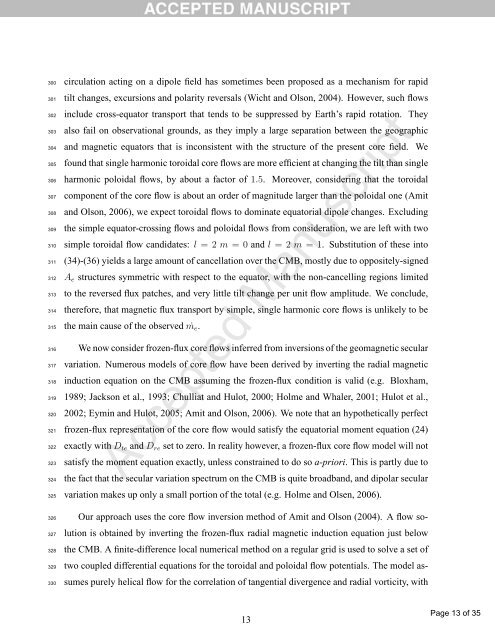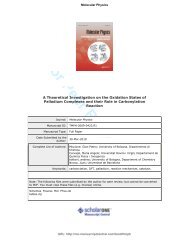Accepted Manuscript - TARA
Accepted Manuscript - TARA
Accepted Manuscript - TARA
Create successful ePaper yourself
Turn your PDF publications into a flip-book with our unique Google optimized e-Paper software.
300<br />
301<br />
302<br />
303<br />
304<br />
305<br />
306<br />
307<br />
308<br />
309<br />
310<br />
311<br />
312<br />
313<br />
314<br />
315<br />
316<br />
317<br />
318<br />
319<br />
320<br />
321<br />
322<br />
323<br />
324<br />
325<br />
circulation acting on a dipole field has sometimes been proposed as a mechanism for rapid<br />
tilt changes, excursions and polarity reversals (Wicht and Olson, 2004). However, such flows<br />
include cross-equator transport that tends to be suppressed by Earth’s rapid rotation. They<br />
also fail on observational grounds, as they imply a large separation between the geographic<br />
and magnetic equators that is inconsistent with the structure of the present core field. We<br />
found that single harmonic toroidal core flows are more efficient at changing the tilt than single<br />
harmonic poloidal flows, by about a factor of 1.5. Moreover, considering that the toroidal<br />
component of the core flow is about an order of magnitude larger than the poloidal one (Amit<br />
and Olson, 2006), we expect toroidal flows to dominate equatorial dipole changes. Excluding<br />
the simple equator-crossing flows and poloidal flows from consideration, we are left with two<br />
simple toroidal flow candidates: l = 2 m = 0 and l = 2 m = 1. Substitution of these into<br />
(34)-(36) yields a large amount of cancellation over the CMB, mostly due to oppositely-signed<br />
A e structures symmetric with respect to the equator, with the non-cancelling regions limited<br />
to the reversed flux patches, and very little tilt change per unit flow amplitude. We conclude,<br />
therefore, that magnetic flux transport by simple, single harmonic core flows is unlikely to be<br />
the main cause of the observed m˙<br />
e .<br />
We now consider frozen-flux core flows inferred from inversions of the geomagnetic secular<br />
variation. Numerous models of core flow have been derived by inverting the radial magnetic<br />
induction equation on the CMB assuming the frozen-flux condition is valid (e.g. Bloxham,<br />
1989; Jackson et al., 1993; Chulliat and Hulot, 2000; Holme and Whaler, 2001; Hulot et al.,<br />
2002; Eymin and Hulot, 2005; Amit and Olson, 2006). We note that an hypothetically perfect<br />
frozen-flux representation of the core flow would satisfy the equatorial moment equation (24)<br />
exactly with D te and D re set to zero. In reality however, a frozen-flux core flow model will not<br />
<strong>Accepted</strong> <strong>Manuscript</strong><br />
satisfy the moment equation exactly, unless constrained to do so a-priori. This is partly due to<br />
the fact that the secular variation spectrum on the CMB is quite broadband, and dipolar secular<br />
variation makes up only a small portion of the total (e.g. Holme and Olsen, 2006).<br />
326<br />
327<br />
328<br />
329<br />
330<br />
Our approach uses the core flow inversion method of Amit and Olson (2004). A flow solution<br />
is obtained by inverting the frozen-flux radial magnetic induction equation just below<br />
the CMB. A finite-difference local numerical method on a regular grid is used to solve a set of<br />
two coupled differential equations for the toroidal and poloidal flow potentials. The model assumes<br />
purely helical flow for the correlation of tangential divergence and radial vorticity, with<br />
13<br />
Page 13 of 35
















